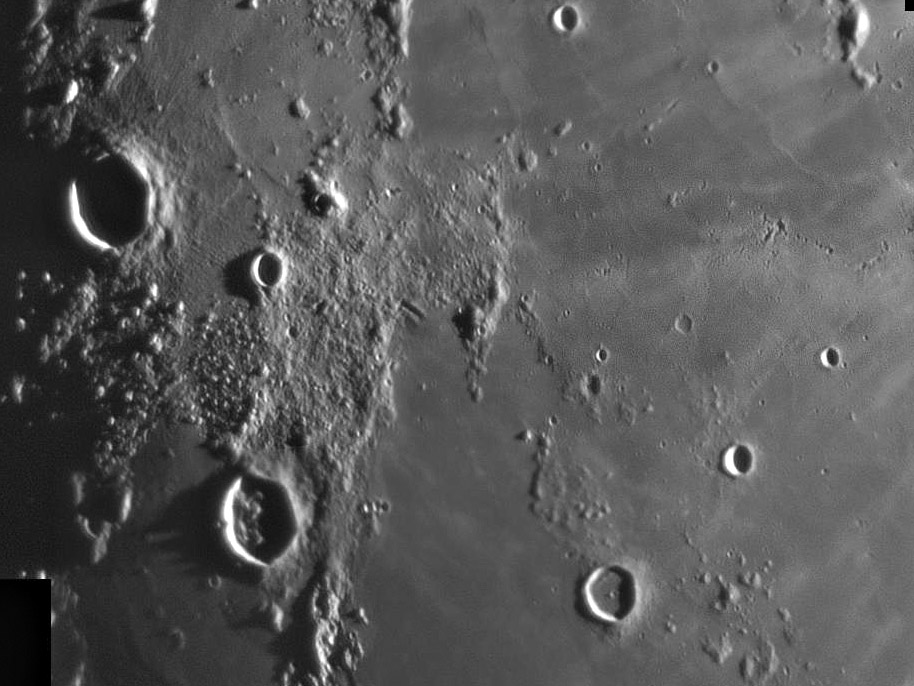Difference between revisions of "April 19, 2010"
| Line 3: | Line 3: | ||
<!-- ws:start:WikiTextHeadingRule:1:<h1> --> | <!-- ws:start:WikiTextHeadingRule:1:<h1> --> | ||
<!-- ws:start:WikiTextLocalImageRule:16:<img src="/file/view/LPOD-Apr-19-10.jpg/135184511/LPOD-Apr-19-10.jpg" alt="" title="" /> -->[[File:LPOD-Apr-19-10.jpg|LPOD-Apr-19-10.jpg]]<!-- ws:end:WikiTextLocalImageRule:16 --><br /> | <!-- ws:start:WikiTextLocalImageRule:16:<img src="/file/view/LPOD-Apr-19-10.jpg/135184511/LPOD-Apr-19-10.jpg" alt="" title="" /> -->[[File:LPOD-Apr-19-10.jpg|LPOD-Apr-19-10.jpg]]<!-- ws:end:WikiTextLocalImageRule:16 --><br /> | ||
| − | <em>image by [mailto:rhill@lpl.arizona.edu | + | <em>image by [mailto:rhill@lpl.arizona.edu Richard Hill], Tucson, Arizona</em><br /> |
<br /> | <br /> | ||
| − | Kepler, Encke and Kunowsky are three of a kind. Each crater has a polygonal outline, delta-shaped rim profile, and shallow floor. Kunowsky (bottom right) has a lava-flooded floor with a bit of a central peak and terrace segment. Encke (bottom left with long rim shadows) is a floor-fractured crater, with part of a fracture showing brightly. Kepler (top left) is shadow-filled, but previous [http://www.lpod.org/archive/LPOD-2005-05-01.htm | + | Kepler, Encke and Kunowsky are three of a kind. Each crater has a polygonal outline, delta-shaped rim profile, and shallow floor. Kunowsky (bottom right) has a lava-flooded floor with a bit of a central peak and terrace segment. Encke (bottom left with long rim shadows) is a floor-fractured crater, with part of a fracture showing brightly. Kepler (top left) is shadow-filled, but previous [http://www.lpod.org/archive/LPOD-2005-05-01.htm views] reveal it to have slumped walls that encroach into the floor, embayed by patches of smooth material. The different interiors show that it is the polygonal shape and delta walls that are most unique about these craters. To the east that are two more similar craters, Gambart and Reinhold B. There must be some reason for the concentration of these unusual craters here. I wonder if it is that they impacted into very thin layers of mare lavas over thick Imbrium ejecta? I don't know of any modeling or experiments that would explain why impact into basin ejecta - presumably less consolidated than mare - would cause polygonal outlines. At Meteor Crater in Arizona, the strongly polygonal rim edges align with regional lines of weakness. The edges of these three lunar craters are roughly parallel, perhaps there is a regional stress field here.<br /> |
<br /> | <br /> | ||
| − | <em>[mailto:tychocrater@yahoo.com | + | <em>[mailto:tychocrater@yahoo.com Chuck Wood]</em><br /> |
<br /> | <br /> | ||
<strong>Technical Details</strong><br /> | <strong>Technical Details</strong><br /> | ||
| Line 16: | Line 16: | ||
<br /> | <br /> | ||
<hr /> | <hr /> | ||
| − | <div>You can support LPOD when you buy any book from Amazon thru [http://www.lpod.org/?page_id=591 | + | <div>You can support LPOD when you buy any book from Amazon thru [http://www.lpod.org/?page_id=591 LPOD!]<br /> |
</div> | </div> | ||
---- | ---- | ||
===COMMENTS?=== | ===COMMENTS?=== | ||
| − | + | Register, and click on the <b>Discussion</b> tab at the top of the page. | |
Revision as of 17:18, 11 January 2015
Three of a Kind

image by Richard Hill, Tucson, Arizona
Kepler, Encke and Kunowsky are three of a kind. Each crater has a polygonal outline, delta-shaped rim profile, and shallow floor. Kunowsky (bottom right) has a lava-flooded floor with a bit of a central peak and terrace segment. Encke (bottom left with long rim shadows) is a floor-fractured crater, with part of a fracture showing brightly. Kepler (top left) is shadow-filled, but previous views reveal it to have slumped walls that encroach into the floor, embayed by patches of smooth material. The different interiors show that it is the polygonal shape and delta walls that are most unique about these craters. To the east that are two more similar craters, Gambart and Reinhold B. There must be some reason for the concentration of these unusual craters here. I wonder if it is that they impacted into very thin layers of mare lavas over thick Imbrium ejecta? I don't know of any modeling or experiments that would explain why impact into basin ejecta - presumably less consolidated than mare - would cause polygonal outlines. At Meteor Crater in Arizona, the strongly polygonal rim edges align with regional lines of weakness. The edges of these three lunar craters are roughly parallel, perhaps there is a regional stress field here.
Chuck Wood
Technical Details
26 March, 2010, 04:08 UT. C14 + 2X barlow f/22 + UV/IR blocking filter + DMK 21AU04. 200/2000 images. Registax 5 for the coadding of images and wavelet filtering and then iMerge for the making of the montage and PhotoWise plus Gimp for final touch up.
Related Links
Rükl plate 30
COMMENTS?
Register, and click on the Discussion tab at the top of the page.



